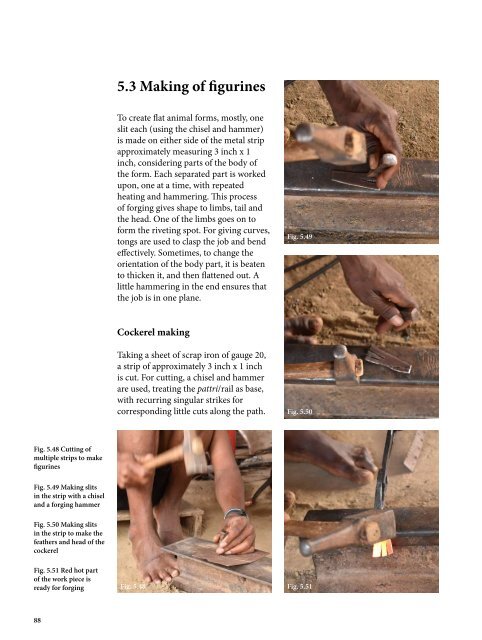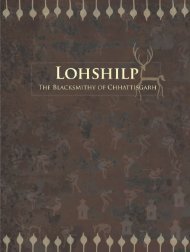CRAFT DOC_compressed
Create successful ePaper yourself
Turn your PDF publications into a flip-book with our unique Google optimized e-Paper software.
5.3 Making of figurines<br />
To create flat animal forms, mostly, one<br />
slit each (using the chisel and hammer)<br />
is made on either side of the metal strip<br />
approximately measuring 3 inch x 1<br />
inch, considering parts of the body of<br />
the form. Each separated part is worked<br />
upon, one at a time, with repeated<br />
heating and hammering. This process<br />
of forging gives shape to limbs, tail and<br />
the head. One of the limbs goes on to<br />
form the riveting spot. For giving curves,<br />
tongs are used to clasp the job and bend<br />
effectively. Sometimes, to change the<br />
orientation of the body part, it is beaten<br />
to thicken it, and then flattened out. A<br />
little hammering in the end ensures that<br />
the job is in one plane.<br />
Fig. 5.49<br />
Cockerel making<br />
Taking a sheet of scrap iron of gauge 20,<br />
a strip of approximately 3 inch x 1 inch<br />
is cut. For cutting, a chisel and hammer<br />
are used, treating the pattri/rail as base,<br />
with recurring singular strikes for<br />
corresponding little cuts along the path.<br />
Fig. 5.50<br />
Fig. 5.48 Cutting of<br />
multiple strips to make<br />
figurines<br />
Fig. 5.49 Making slits<br />
in the strip with a chisel<br />
and a forging hammer<br />
Fig. 5.50 Making slits<br />
in the strip to make the<br />
feathers and head of the<br />
cockerel<br />
Fig. 5.51 Red hot part<br />
of the work piece is<br />
ready for forging<br />
Fig. 5.48<br />
Fig. 5.51<br />
88




